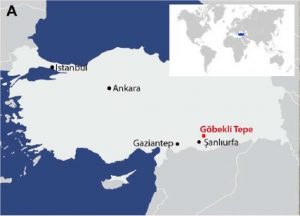I’m going to take a little time out from my series about America’s science decline to discuss some of the recent finds made at the archeological site Gobekli Tepe, considered the world’s oldest known temple complex. The discovery of human skulls that had been deliberately modified indicate that the ancient people who erected the monumental T-shaped carved stones may have decorated the structures with the skulls.
First a bit of background. Gobekli Tepe (which means Potbelly Hill in Turkish) is an archeological site in southeastern Turkey (see map below). Dated to about 8,000 BCE the “Temple” consists of four oval shaped stone walls each of which contains a number of T-shaped, stone slabs with exquisitely carved animal representations on them. To date there is no evidence of human habitation at the site, it appears to have been used solely for ritual ceremonies. See pictures below the map to get an idea of the site.



In a recent article in the journal ‘Science Advances’ by Julia Gresky, Juliane Haelm and Lee Clare of the German Archeological Institute, the discovery at Gobekli Tepe of three human skulls was reported. Now these were not burials, only skulls were found and the skulls had been deliberately modified by flint tools to produce linear grooves in them. Doctor Gresky et al suggest that these skulls may have been used as decorations on Gobekli Tepe’s stone slabs. One of the skulls discovered also had a hole that had been drilled very precisely into it’s top that could have enabled it to have been hung with a short piece of rope.
This discovery fits in with similar finds from other sites in the region, finds that indicate that Anatolia (an old name for Turkey-Syria) was the home for a skull-cult culture where people would bury their dead and then later dig them up, removing the skulls for display. The question of whether these skulls were venerated ancestors or mutilated enemies is unknown at present but Doctor Gresky hopes further finds will give us an answer.
Indeed the studies going on at Gobekli Tepe in the twenty years since its discovery have raised many more questions than answers. Other evidence from the time period indicate that the surrounding region was inhabited solely by small groups of hunter gatherers, not the sort of society normally associated with the construction of monumental stone structures. Did groups of nomads use Gobekli Tepe as a meeting place, perhaps as a fixed boundary marker as well. Both uses intended to keep peace between the different clans.
If that is true, how did these different groups organize themselves for the construction, feed themselves etc. Hopefully more excavations, more finds will help us learn some of the answers. If you’d like to read more about the recent Skull finds at Gobekli Tepe click on the link below to read the National Geographic’s article.
http://news.nationalgeographic.com/2017/06/skulls-cult-turkey-archaeology-neolithic-gobekli/
Next time I’ll return to my discussion concerning the decline of American Science.

Helpful information. Fortunate me I discovered your site accidentally, and I’m surprised why
this twist of fate did not took place in advance!
I bookmarked it.
Thanks for the comment and come back soon!
Bob L
I am truly pleased to glance at this web
site posts which contains tons of useful data, thanks for providing such data.
Thanks for the comment and come back soon!
Bob L